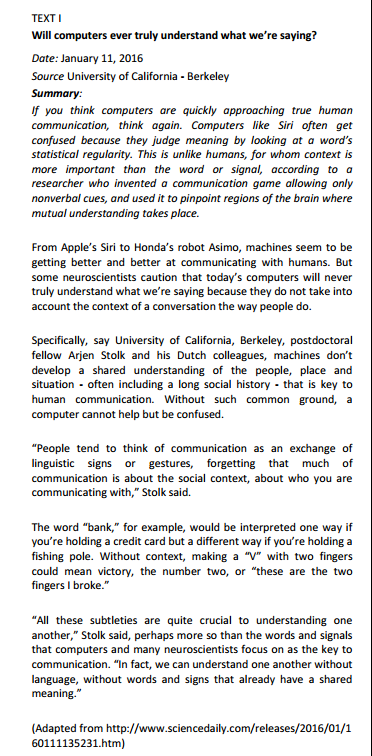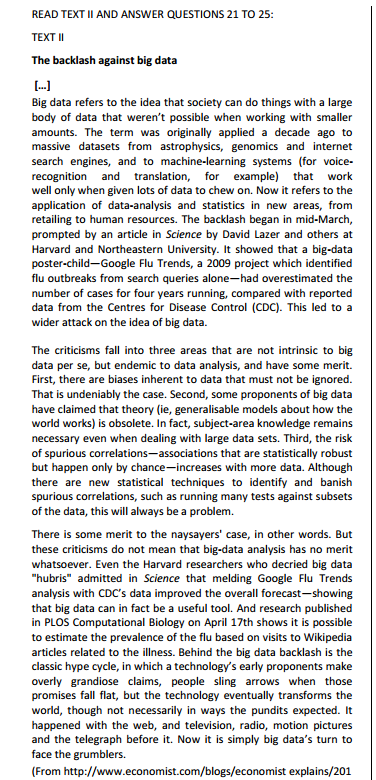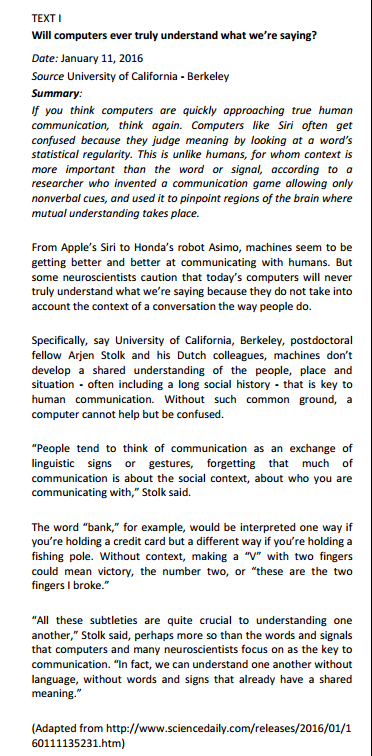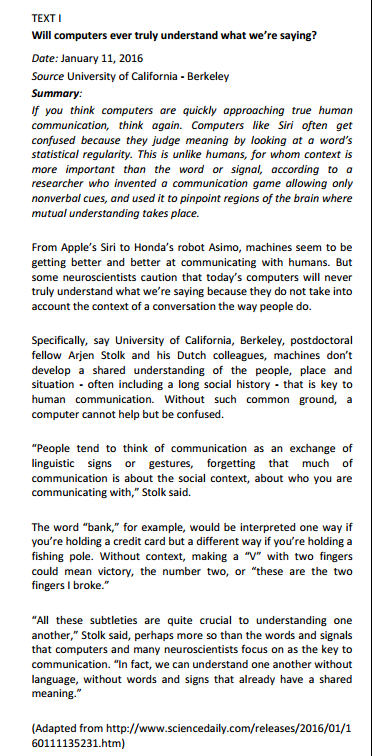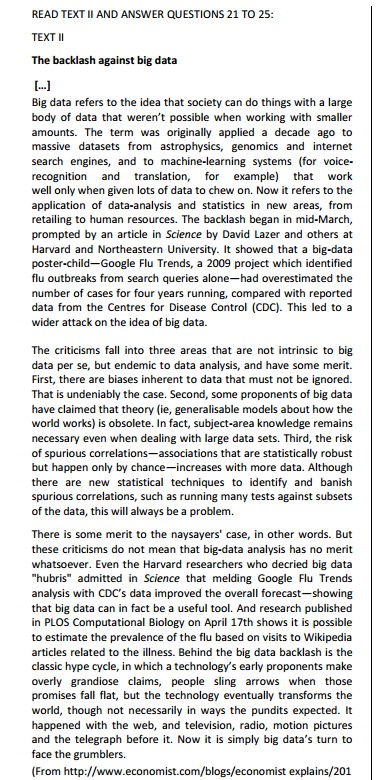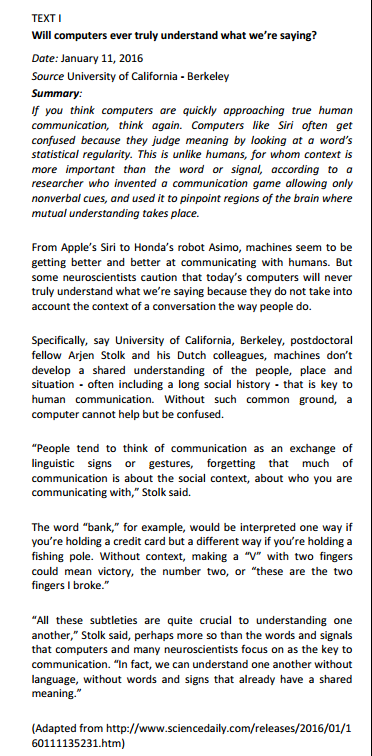Read the text and answer question.
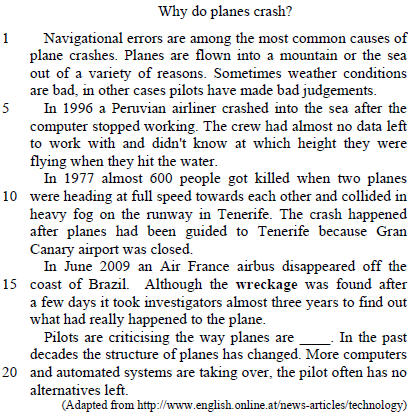
According to the text, write (T) for the true statements and (F) for the false statements.
( ) In 1977 two planes collided in Tenerife.
( ) In 1977 almost 600 people were killed due to heavy fog on the runway.
( ) In 1977 two planes collided when they were heading for Gran Canary airport.
( ) In 1977 two planes were guided to Gran Canary airport because Tenerife was closed.
Choose the alternative that corresponds to the order.

Judge the following items according to the text CB3A1AAA.
In spite of being a longstanding matter, concurrent computation has been used just by professionals who implement database management systems.
People with disabilities can use websites and web tools
when they are properly designed. However, currently many sites
and tools are developed with accessibility barriers that make it
difficult or impossible for some people to use them.
The absence of an alternative text is the classic example.
Sites and tools with images should include equivalent alternative
text in the markup/code.
If an alternative text is not provided for images, the image
information is inaccessible, for example, to people who cannot see
and have to use a screen reader that reads aloud the information on
a page, including the alternative text for the visual image.
When an equivalent alternative text is presented, in HTML
format, for example, information is available to everyone to people
who are blind, as well as to people who turned off images on their
mobile phone to lower bandwidth charges, people in a rural area
with low bandwidth who turned off images to speed download, and
others. It is also available to technologies that cannot see the image,
such as search engines.
Another example of barrier is the lack of keyboard input.
Some people cannot use a mouse, including many elderly users with
limited fine motor control. An accessible website does not rely on
the mouse; it provides all functionality via a keyboard.
Just as images are not available to people who cannot see,
audio files are not available to people who cannot hear. Providing
a text transcript makes the audio information accessible to people
who are deaf or hard of hearing.
It is easy and relatively inexpensive for website developers
to provide transcripts for podcasts and audio files. There are also
transcription services that create text transcripts in HTML format.
Most of the basics of accessibility are even easier and less
expensive than providing transcripts. However, the proper
techniques are poorly integrated into some web tools, education,
and development processes.
Internet: <https://www.w3.org> (adapted).
Judge the following items according to the text above.
Providing access to contents through keyboard input makes websites much more friendly for older people as well.
From the fragment of the text “Although oil and natural gas prices have decoupled in recent years, there is still an indirect link between the price of oil and the price of natural gas, because both oil and natural gas are often produced from the same well” (lines 38-42), it can be inferred that
According to the researchers from the University of California, Berkeley:
Based on the summary provided for Text I, mark the statements
below as TRUE (T ) or FALSE (F ).
( ) Contextual clues are still not accounted for by computers.
( ) Computers are unreliable because they focus on language
patterns.
( ) A game has been invented based on the words people use.
The statements are, respectively:
The three main arguments against big data raised by Text II in the second paragraph are:
The word “so” in “perhaps more so than the words and signals” is used to refer to something already stated in Text I. In this context, it refers to:
READ TEXT I AND ANSWER QUESTIONS 11 TO 15
TEXT I
Will computers ever truly understand what we're saying?
Date: January 11, 2016
Source University of California - Berkeley
Summary:
If you think computers are quickly approaching true human
communication, think again. Computers like Siri often get
confused because they judge meaning by looking at a word's
statistical regularity. This is unlike humans, for whom context is
more important than the word or signal, according to a
researcher who invented a communication game allowing only
nonverbal cues, and used it to pinpoint regions of the brain where
mutual understanding takes place.
From Apple's Siri to Honda's robot Asimo, machines seem to be
getting better and better at communicating with humans. But
some neuroscientists caution that today's computers will never
truly understand what we're saying because they do not take into
account the context of a conversation the way people do.
Specifically, say University of California, Berkeley, postdoctoral
fellow Arjen Stolk and his Dutch colleagues, machines don't
develop a shared understanding of the people, place and
situation - often including a long social history - that is key to
human communication. Without such common ground, a
computer cannot help but be confused.
"People tend to think of communication as an exchange of
linguistic signs or gestures, forgetting that much of
communication is about the social context, about who you are
communicating with," Stolk said.
The word "bank," for example, would be interpreted one way if
you're holding a credit card but a different way if you're holding a
fishing pole. Without context, making a "V" with two fingers
could mean victory, the number two, or "these are the two
fingers I broke."
"All these subtleties are quite crucial to understanding one
another," Stolk said, perhaps more so than the words and signals
that computers and many neuroscientists focus on as the key to
communication. "In fact, we can understand one another without
language, without words and signs that already have a shared
meaning."
(Adapted from http://www.sciencedaily.com/releases/2016/01/1
60111135231.htm)
According to the researchers from the University of California, Berkeley:
Based on the summary provided for Text I, mark the statements
below as TRUE (T ) or FALSE (F ).
( ) Contextual clues are still not accounted for by computers.
( ) Computers are unreliable because they focus on language
patterns.
( ) A game has been invented based on the words people use.
The statements are, respectively:
The three main arguments against big data raised by Text II in the second paragraph are:
According to the researchers from the University of California, Berkeley:
READ TEXT I AND ANSWER QUESTIONS 16 TO 20
TEXT I
Will computers ever truly understand what we're saying?
Date: January 11, 2016
Source University of California - Berkeley
Summary:
If you think computers are quickly approaching true human
communication, think again. Computers like Siri often get
confused because they judge meaning by looking at a word's
statistical regularity. This is unlike humans, for whom context is
more important than the word or signal, according to a
researcher who invented a communication game allowing only
nonverbal cues, and used it to pinpoint regions of the brain where
mutual understanding takes place.
From Apple's Siri to Honda's robot Asimo, machines seem to be
getting better and better at communicating with humans. But
some neuroscientists caution that today's computers will never
truly understand what we're saying because they do not take into
account the context of a conversation the way people do.
Specifically, say University of California, Berkeley, postdoctoral
fellow Arjen Stolk and his Dutch colleagues, machines don't
develop a shared understanding of the people, place and
situation - often including a long social history - that is key to
human communication. Without such common ground, a
computer cannot help but be confused.
“People tend to think of communication as an exchange of
linguistic signs or gestures, forgetting that much of
communication is about the social context, about who you are
communicating with," Stolk said.
The word “bank," for example, would be interpreted one way if
you're holding a credit card but a different way if you're holding a
fishing pole. Without context, making a “V" with two fingers
could mean victory, the number two, or “these are the two
fingers I broke."
“All these subtleties are quite crucial to understanding one
another," Stolk said, perhaps more so than the words and signals
that computers and many neuroscientists focus on as the key to
communication. “In fact, we can understand one another without
language, without words and signs that already have a shared
meaning."
(Adapted from http://www.sciencedaily.com/releases/2016/01/1
60111135231.htm)
The title of Text I reveals that the author of this text is:





